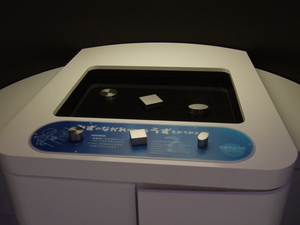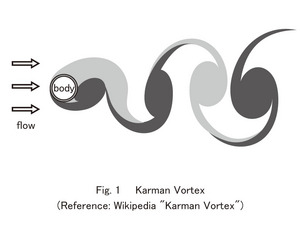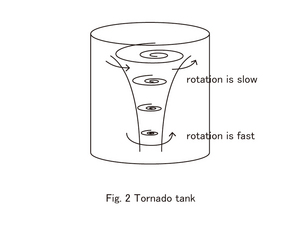Nagoya City Science Museum
TOP > Exhibition Guide > Keyword Search > Starting with "S" > Shishiodoshi > Flow and Vortex
Flow and Vortex



Purpose of Exhibition
Water on the ground evaporates and turns into vapor. It soars upwards and makes clouds in the sky. Over time clouds are transformed into rain (water), which returns to the ground and pours into the ocean. Water circulates on the earth. In this "Exploring Water" exhibition, you can deepen your knowledge about this big circulation and characteristics of water through various experiments.
We will explain two exhibits in this "River Stage".
Additional Knowledge
[Karman Vortex]
When an object is put in the flow of a water current, a line of vortex is formed behind the object. This vortex is called the Karman Vortex, which is taken from the discoverer's name (Figure 1).
This exhibit is an experiment device that puts an object into water, which disturbs the water current; we would like you to observe the vortex behind it. The vortex shows quite a different shape depending on the shape of the object. Please observe those vortex shapes carefully.
It seems hard to confirm the second and third vortex-like small water current and object in this exhibit. However, the Karman Vortex affects other natural phenomenon that should not be ignored. For example, in 1940, a big accident that caused the collapse of Tacoma Bridge occurred in Washington, United States. The cause of the accident was analyzed, and it was determined that because the bridge was constructed with an H type surface and suffered from a strong crosswind, a Karman Vortex occurred as a result. It created resonance phenomenon and the bridge collapsed.
[Water Seesaw]
Do you know Shishiodoshi? This exhibit, "Water Seesaw" is a Shishiodoshi motif. Shishiodoshi is a device which makes a sound by using water in a Japanese garden. Originally, the device gives out a threat signal to beasts and birds that damage agriculture and it is generically called Shishiodoshi. Though a scarecrow is also one of them, Shishiodoshi is generally indicated by Sozu (a type of water fountain).
Sozu is made of bamboo tube. You make a fulcrum around the center, open one of the ends, and pour water into the bamboo tube. As the water beings to be poured, the gravity point is in the bottom end from the fulcrum. When water has filled the tube completely, gravity moves from the fulcrum to the mouth end, the bamboo tube inclines, discharges water and becomes empty. Then, it returns to the former inclination. At this moment, it hits a stone and makes a sound. Sozu in Shisen-d_, Kyoto, is very famous.
[Waterwheels]
There are four exhibitions here, "Back shot water wheel", "Overshot water wheel", "Breast shot water wheel" and "Undershot water wheel". Please view them as monuments which use water current.
[Making Maelstroms]
When the plug of a tank with a lot of water is pulled out, water is sucked into a hole and makes a big vortex. This exhibit demonstrates this phenomenon. You can see the rotation of the vortex current is fast near the hole and slow around the surface of the water (Figure 2).This is because, as the water moves to the internal direction, the rotational speed increases to save angular momentum. Instantaneous speed of particles in the vortex is inversely proportional to the radius of vortex.
Article by Koichi Mabuchi
